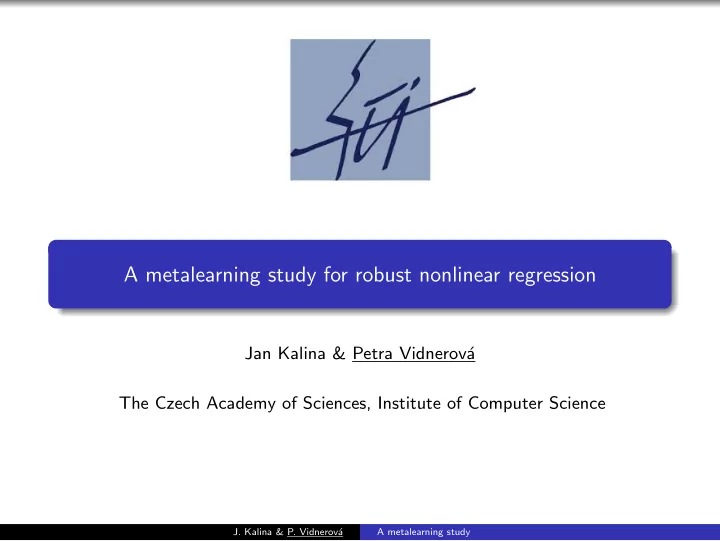

A metalearning study for robust nonlinear regression Jan Kalina & Petra Vidnerov´ a The Czech Academy of Sciences, Institute of Computer Science J. Kalina & P. Vidnerov´ a A metalearning study
Metalearning: motivation, principles Transfer learning for automatic method selection Automatic algorithm selection Empirical approach for (black-box) comparison of methods Attempt to generalize information across datasets Learn prior knowledge from previously analyzed datasets and exploit it for a given dataset A dataset (instance) viewed as a point in a high-dimensional space J. Kalina & P. Vidnerov´ a A metalearning study
Nonlinear regression Model Y i = f ( β 1 X i 1 , . . . , β p X ip ) + e i , i = 1 , . . . , n Nonlinear least squares (NLS) Minimal sum of squares Vulnerability to outliers J. Kalina & P. Vidnerov´ a A metalearning study
Nonlinear least weighted squares estimator (NLWS) Y i = f ( β 0 + β 1 X i 1 + · · · + β p X ip ) + e i , i = 1 , . . . , n Y = ( Y 1 , . . . , Y n ) T = continuous outcome f = given nonlinear function Nonlinear least squares: sensitive to outliers Residuals for a fixed b = ( b 0 , b 1 , . . . , b p ) T ∈ ❘ p +1 : u i ( b ) = Y i − f ( b 0 − b 1 X i 1 − · · · − b p X ip ) , i = 1 , . . . , n Squared residuals arranged in ascending order: u 2 (1) ( b ) ≤ u 2 (2) ( b ) ≤ · · · ≤ u 2 ( n ) ( b ) . Nonlinear least weighted squares (NLWS): n b = ( b 0 , b 1 , . . . , b p ) T ∈ ❘ p +1 , � w i u 2 b LWS = arg min ( i ) ( b ) over i =1 where w 1 , . . . , w n are given magnitudes of weights. J. Kalina & P. Vidnerov´ a A metalearning study
Nonlinear least weighted squares estimator (NLWS) Examples of weight functions: � n i =1 w i = 1 Nonlinear least trimmed squares (NLTS): 0-1 weights J. Kalina & P. Vidnerov´ a A metalearning study
Meta-learning process J. Kalina & P. Vidnerov´ a A metalearning study
Data acquisition and pre-processing We start with 2000 real publicly available datasets (github) Diversity of domains Automatic downloading Pre-processing in Python Reducing n Missing values Categorical variables Reducing p Y i − min i Y i Y i �− max i Y i − min i Y i , i = 1 , . . . , n → Standardizing continuous regressors J. Kalina & P. Vidnerov´ a A metalearning study
Description of the metalearning study) Datasets 721 real datasets Algorithms Fully automatic, including finding suitable parameters Least squares & 6 robust nonlinear estimators (NLTS, NLWS with various weights, nonlinear regression median) Prediction measure Mean square error (MSE) evaluated within a cross validation Robust versions: trimmed MSE (TMSE), weighted MSE (WMSE) n h n MSE = 1 TMSE( α ) = 1 � r 2 � r 2 � w i r 2 WMSE = i , ( i ) , ( i ) n h i =1 i =1 i =1 Features of the datasets 9 features Metalearning (performed over metadata) Classification by means of various classifiers J. Kalina & P. Vidnerov´ a A metalearning study
Selected 10 features of the datasets 1 The number of observations n 2 The number of variables p 3 The ratio n / p 4 Normality of residuals ( p -value of Shapiro-Wilk test) 5 Skewness of residuals 6 Kurtosis of residuals Coefficient of determination R 2 , 7 8 Percentage of outliers (estimated by the LTS) – important! 9 Heteroscedasticity ( p -value of Breusch-Pagan test) 10 Donoho-Stahel outlyingness measure of X J. Kalina & P. Vidnerov´ a A metalearning study
Primary learning Model p p X j ) 2 + e i , β p + j ( X ij − ¯ � � Y i = β 0 + β j X ij + i = 1 , . . . , n j =1 j =1 Leave-one-out cross validation MSE: NLS yields the minimal prediction error for 23 % of the datasets, NLTS 26 % any of the versions of the NLWS 31 % nonlinear median 20 % TMSE: NLTS best for 39 % of datasets NLWS 35 % WMSE: NLTS best for 34 % of datasets NLWS 45 % Weights for the NLWS: no choice uniformly best J. Kalina & P. Vidnerov´ a A metalearning study
Secondary learning Results of metalearning evaluated as the classification accuracy in a leave-one-out cross validation study. Three different prediction error measures are compared. Classification accuracy Classification method MSE TMSE WMSE Classification tree 0.35 0.45 0.47 k -nearest neighbor ( k = 3) 0.56 0.61 0.64 LDA 0.60 0.68 0.65 SCRDA 0.60 0.68 0.66 Linear MWCD-classification 0.60 0.68 0.66 Multilayer perceptron 0.56 0.66 0.66 Logistic regression 0.56 0.67 0.69 SVM (linear) 0.60 0.69 0.70 SVM (Gaussian kernel) 0.64 0.71 0.70 J. Kalina & P. Vidnerov´ a A metalearning study
Conclusions First comparison of robust nonlinear regression estimates 721 datasets Arguments in favor of the NLWS estimator (robustness & efficiency) Metalearning is useful Future work: robust metalearning Limitations of metalearning: No theory Number of methods/algorithms/features Choice of datasets Too automatic Correct pre-processing (incl. variable selection) of data needed! J. Kalina & P. Vidnerov´ a A metalearning study
Recommend
More recommend